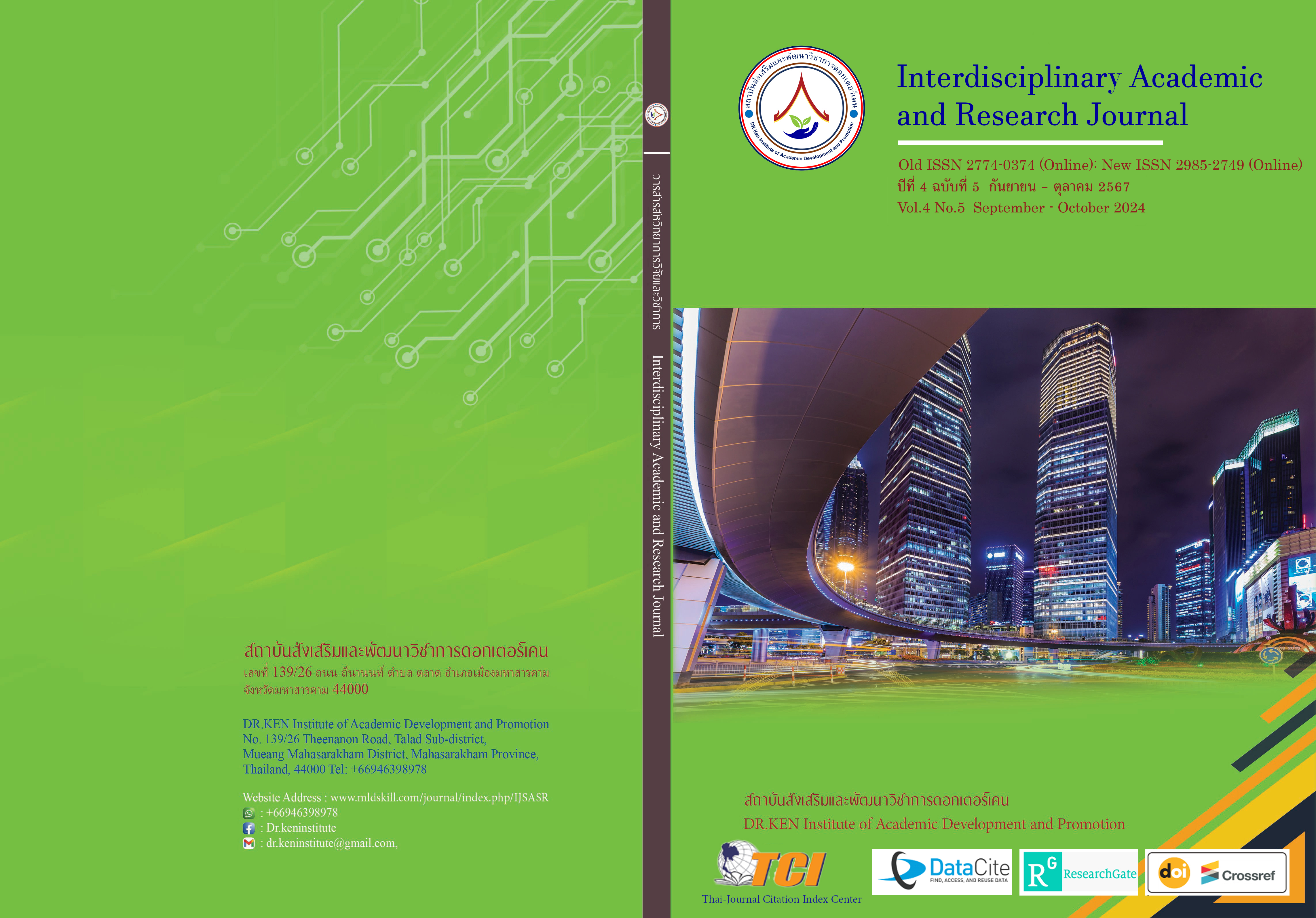The Study of Teacher-child Relationship Competencies of Early Childhood Teachers in Oab-ruk Affiliated Schools (Pseudonym)
DOI:
https://doi.org/10.60027/iarj.2024.277167Keywords:
Competencies of Early Childhood Teachers; , Relationships between Teachers and ChildrenAbstract
Background and Aims: Early childhood educators can cultivate positive relationships with children by valuing and appreciating each child's individual qualities. Children should receive an education that is tailored to their individual needs and abilities, taking into account their humanity in a setting that differs from that of adults. This exploratory research aims to study the competencies of early childhood teachers in the relationship between teachers and children in the Obrak School Group (pseudonyms) in 6 areas: 1) respecting individual differences, 2) accepting commonality, 3) respecting diversity, 4) building psychological attachment and safety, 5) Uses of language and tone reflecting respect, and 6) building trust.
Methodology: The sample group used to collect quantitative data was 103 people and qualitative data was 18 people. Tools used in the research included questionnaires, behavioral observation forms, interviews, and surveys. Data were analyzed using statistics of mean values, percentage values, standard deviation and content analysis.
Results: Early childhood educators are highly competent in their interactions with students. Taking into account all the factors, it was discovered that the use of language and tone of voice that conveys acceptance and respect is highly proficient. has the highest average score, with building trust coming in second. Increasing psychological safety and engagement, appreciating each child's individuality, accepting age, developmental, and ability differences, and valuing diversity within the framework of a multicultural society are all important. Examine the early childhood teachers' trust-related competencies were the ones that caused the most issues in the relationships between teachers and students in the Obrak School Group (pseudonyms). When it comes to teaching kids how to follow routines and activities. Respect for diversity in a multicultural society comes next. Regarding the subject of embracing linguistic, religious, and multicultural diversity.
Conclusion: The results demonstrate how exceptionally skilled early childhood educators are at creating positive interactions, especially when they use language and tone that communicates acceptance and respect—a crucial component in developing trust. To improve teacher-student relationships, it is crucial to address trust-related competencies, with a particular focus on embracing linguistic, religious, and multicultural diversity for inclusive education. Nevertheless, challenges primarily stem from these competencies.
References
กระทรวงศึกษาธิการ. (2560). หลักสูตรการศึกษาปฐมวัย พุทธศักราช 2560. กรุงเทพฯ: ชุมนุมสหกรณ์การเกษตรแห่งประเทศไทย
คณะผู้บริหารเครือโรงเรียนโอบรัก (2565). คู่มือการปฏิบัติงานของครูโรงเรียนโอบรัก. ชลบุรี: ชลบุรีการพิมพ์
คณะสังคมศาสตร์ มหาวิทยาลัยเกษตรศาสตร์ (2563). รายงานการพัฒนาเด็กและเยาวชน. Retreived from: https://www.dcy.go.th/public/mainWeb/file_download/1664788620103-248403179.pdf
ตรีนุช ไพชยนต์วิจิตร และ สรัลชนา ธิติสวรรค์. (2565). ผลกระทบการแพร่ระบาดของโควิด-19 ต่อการศึกษา. Retrieved from: http://www.eco.ru.ac.th/images/document/article/TreeNut/publish02-02.pdf
วรรณี แกมเกตุ. (2555). วิธีวิทยาการวิจัยทางพฤติกรรมศาสตร์. พิมพ์ครั้งที่ 3: จุฬาลงกรณ์มหาวิทยาลัย.
สถาบันพัฒนาอนามัยเด็กแห่งชาติ กรมอนามัย กระทรวงสาธารณสุข. (2561). แนวทางการอบรมเลี้ยงดู ส่งเสริมพัฒนาการและการเรียนรู้ของเด็กอายุต่ำกว่า 3 ปี. กรุงเทพฯ: ซีจีทูล.
สำนักงานเลขาธิการสภาการศึกษา. (2551). ปฐมวัย จุดเริ่มต้นของสันติภาพ. กรุงเทพฯ: วีทีซี คอมมิวนิเคชั่น
สุวรรณ มีทองคำ บุญทวี อรุณมาศ และ สุนีย์ บุญทิม. (2550). รายงานสภาพพฤติกรรมที่เป็นปัญหาของนักเรียนในสถานศึกษาขั้นพื้นฐาน. กรุงเทพฯ: กระทรวงศึกษาธิการ
อัชรา เอบสุขสิริ. (2556). จิตวิทยาสำหรับครู. กรุงเทพฯ: จุฬาลงกรณ์มหาวิทยาลัย.
Bredekamp, S., & Copple, C. (1997). Developmentally Appropriate Practice in Early Childhood Programs. Washington, DC: NAEYC.
Elliott, B. (2002). Measuring the performance of the early childhood educator in practice. Delmar: Thomson Learning.
Honing, A.S. (2002). Secure relationship: Nurturing infant/toddler attachment in early care setting. National association for the education of young children.
John Bowlby, J. (1973). Attachment and loss. 2nd edition. Basic books.
Krejcie, R.V., & Morgan, D.W. (1970). Determining sample size for research activities. Educational and Psychological Measurement, 30(3), 607-610.
National Association for the Education of Young Children. (2012). Competencies for early childhood professionals. Office of early childhood development Virginia department of social services
National Association for the Education of Young Children. (2020). Developmentally appropriate practice. Office of early childhood development Virginia department of social services
National Association for the Education of Young Children: NAEYC. (1997). “NAEYC Issues Revised Position Statement on Developmentally Appropriate Practice in Early Childhood Programs. Young Children, 52 (4), 34-40.
Ostrosky, M.M., & Jung, E.Y. (2010). Building positive teacher-child relationships. Department of health and human services.
Spivak, A.L., & Farran, D.C. (2012). First-Grade Teacher Behaviors and Children's Prosocial Actions in Classrooms. Early Education and Development, 23 (5), 623-639.
Virginia’s Early Childhood Development Alignment Project. (2008). Competencies for early childhood professionals. Office of early childhood development Virginia department of social services
Downloads
Published
How to Cite
Issue
Section
License
Copyright (c) 2024 Interdisciplinary Academic and Research Journal

This work is licensed under a Creative Commons Attribution-NonCommercial-NoDerivatives 4.0 International License.
Copyright on any article in the Interdisciplinary Academic and Research Journal is retained by the author(s) under the under the Creative Commons Attribution-NonCommercial-NoDerivatives 4.0 International License. Permission to use text, content, images, etc. of publication. Any user to read, download, copy, distribute, print, search, or link to the full texts of articles, crawl them for indexing, pass them as data to software, or use them for any other lawful purpose. But do not use it for commercial use or with the intent to benefit any business.
















.png)


